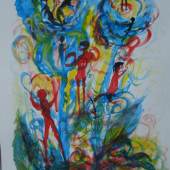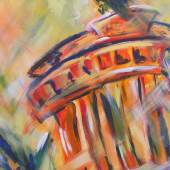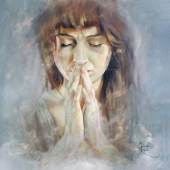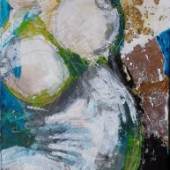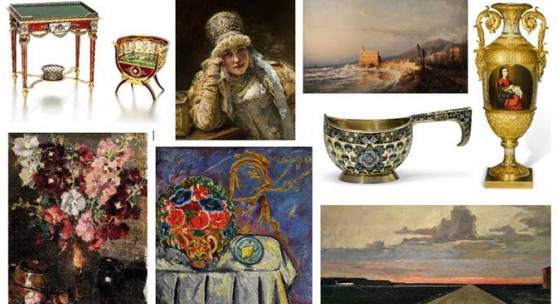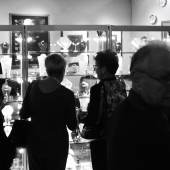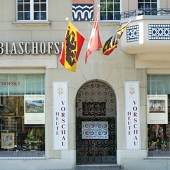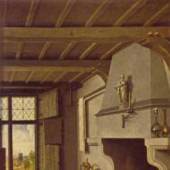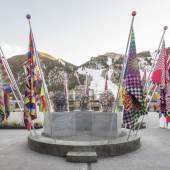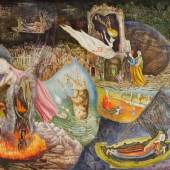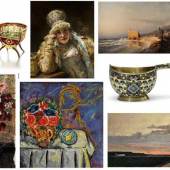RUSSIAN ART HIGHLIGHTS
Nineteenth Century Masterpieces, Rare Russian Avant-Garde Artworks and Exquisite Fabergé and Decorative Arts
-
Auktion04.06.2019
Georgy Grigorievich Nissky, Airfield (Lot 122) Estimate: £60,000 – 80,000
Despite his rising popularity, Nissky was a relatively unknown artist until just 5 years ago. Heavily influenced by Aleksandr Deineka, one of the most important Russian modernist figurative painters of the first half of the 20th century, Nissky is known as the master of the industrial landscape, with his works glorifying Communist ideals. His works are in the State Tretyakov Gallery, the State Russian Museum, and in most of the major museums of the former USSR, with his first retrospective exhibition ‘Nissky. Horizon’ closing at the Institute of Russian Realist Art (IRRA), earlier this year.
Vladimir Weisberg, Still life with loaves and apples on a burgundy tablecloth, 1949 (Lot 140) Estimate: £80,000 – 120,000
From a very sought-after period of the Moscow Non- Conformist artist’s career, this still life is possibly the earliest of his works to ever appear at auction. A colourful canvas created before the artist turned to his monochromatic ‘white on white’ paintings, it is one of three works in the sale from the Michael Karminsky Collection – the collection of Soviet Non- Conformist art in Offenbach, Germany.
Pimen Nikitich Orlov, Portrait of Alexander Nikolaevich Karamzin, 1839 (Lot 7) Estimate: £25,000 – 35,000
This is one of a series of six portraits in the Russian Pictures sale of the Karamzin family. Nikolai Karamzin was a renowned writer and historian who laid the foundation for the future of Russian literature and whose most famous work, a twelve-volume History of the Russian State, was hugely influential.
Executed by two different artists - Jean-Auguste Bard in Italy circa 1835 and Pimen Orlov in Russia between 1836 and 1839, the series depicts Nikolai Mikhailovich Karamzin’s children – Sofia, Andrei, Alexander, Vladimir and Ekaterina – and Karamzin’s son-in-law, Ekaterina’s husband, Petr Meshchersky, with their son Nikolai.
Orlov was still a student at the Imperial Academy of Arts and a pupil of the leading 19th century portraitist Karl Briullov when he was commissioned to paint the three portraits of Karamzin’s children, Andrei, Alexander and Sofia, to complement the works of Bard. This portrait depicting Alexander was among the group of works the artist presented at the 1836 Imperial Academy of Arts exhibition, where he was awarded a second rank silver medal.
RUSSIAN WORKS OF ART, FABERGÉ AND ICONS
 Furniture of Fantasy
A fine and rare Fabergé gold and enamel miniature bonbonnière chair, workmaster Michael Perchin, St Petersburg, circa 1900 (Lot 256) Estimate: £800,000 – 1.2 million A fine and rare Fabergé vari-colored gold, guilloché enamel and nephrite miniature table bonbonnière, workmaster Michael Perchin, St Petersburg, 1899-1908 (Lot 257) Estimate: £800,000 – 1.2 million
Related to the surprises found in Fabergé Imperial Eggs and amongst the most artistically creative works by the firm, miniature pieces of furniture are as rare as they are ingenious. Designed by Fabergé’s most famous workmasters, these miniature objects of fantasy were conceived to delight the firm’s very important collectors, such as members of the Imperial Family, J.P. Morgan, Leopold de Rothschild and Maximillian Othmar Neuscheller, amongst others. Many examples subsequently passed to equally prestigious collections all over the world, such as the British Royal Collection, the Hermitage, the Forbes Magazine Collection, King Farouk of Egypt and the Link of Times Foundation, held at the Fabergé Museum in St Petersburg.
In their ability to transform enamel and gold into rich trompe l’oeil mahogany grain and lustrous silks, replicating elegant architectural design on a miniature scale, the present Empire chair and Louis XVI table represent some of the most artistically luxurious works ever made by Fabergé. Made as bonbonnières, both pieces are at once purely whimsical in their scale and inspired in their use of diverse materials to emulate palace furniture, as well as ingeniously functional.
The gold and guilloche enamel Empire style chair, whose front is prominently decorated with a gold knob encircled in laurel was once in the collection of Grand Duchess Maria Pavlovna and Grand Duke Vladimir Alexandrovich of Russia, and was exhibited in the Charity Exhibition of Fabergé Artistic Objects, Old Miniatures and Snuff Boxes in St Petersburg in 1902, which featured pieces from the Imperial Family’s Fabergé collection. The Grand Duchess shared a passion for Fabergé with Empress Maria Feodorovna and her collection was formed of many of the finest pieces ever made by the firm.
One of only a few known examples of its kind, the design of the table by Michail Perchin exhibits Fabergé’s famous whimsy paired with functional design: its top subtly incorporating a hinge to reveal an internal compartment. Once part of the Forbes Magazine Collection, a closely related example exists in the British Royal Collection of Her Majesty Queen Elizabeth II.
-
05.10.2019 - 13.10.2019Am 5. Oktober rollt die FAIR FOR ART Vienna der Kunst zum dritten Mal den roten Teppich aus. Mehr...
-
Zweimal jährlich, Anfang Mai und Anfang November, führen wir umfangreiche, mehrere Tage...
-
Man nimmt an, dass es sich bei Robert Campin um jenen Maler handelt, der unter dem Namen "...
-
20.04.2024 - 24.11.2024Jeffrey Gibson on Representing the United States and Himself By Melissa Smith | Feb 16, 2024 From...
-
13.05.2024 - 15.05.2024Sotheby’s Sealed is thrilled to present this spectacular Mercedes-Benz 300 SL Alloy...
-
14.05.2024Warhol & Basquiat’s Collaboration Series Masterwork To Highlight Sotheby’s...
-
15.05.2024T he most significant work by the celebrated Surrealist artist Leonora Carrington, Les...
-
04.06.2019Auktion »
.

